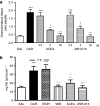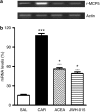Cannabinoids reduce granuloma-associated angiogenesis in rats by controlling transcription and expression of mast cell protease-5
- PMID: 18552882
- PMCID: PMC2518473
- DOI: 10.1038/bjp.2008.211
Cannabinoids reduce granuloma-associated angiogenesis in rats by controlling transcription and expression of mast cell protease-5
Erratum in
- Br J Pharmacol. 2008 Aug;154(8):1701. Concetta, P [corrected to Pietropaolo, C]
Abstract
Background and purpose: Chronic inflammatory conditions, such as granulomas, are associated with angiogenesis. Mast cells represent the main cell type orchestrating angiogenesis, through the release of their granule content. Therefore, compounds able to modulate mast cell behaviour may be considered as a new pharmacological approach to treat angiogenesis-dependent events. Here, we tested the effect of selective cannabinoid (CB) receptor agonists in a model of angiogenesis-dependent granuloma formation induced by lambda-carrageenin in rats.
Experimental approach: Granulomas were induced by lambda-carrageenin-soaked sponges implanted subcutaneously on the back of male Wistar rats. After 96 h, implants were removed and granuloma formation was measured (wet weight); angiogenesis was evaluated by histological analysis and by the measurement of haemoglobin content. Mast cells in the granulomas were evaluated histologically and by RT-PCR and immunoblotting analysis for mast cell-derived proteins (rat mast cell protease-5 (rMCP-5) and nerve growth factor). Selective CB1 and CB2 receptor agonists(,) ACEA and JWH-015 (0.001-0.1 mg mL(-1)), were given locally only once, at the time of implantation.
Key results: The CB1 and CB2 receptor agonists decreased the weight and vascularization of granulomas after 96 h. This treatment also reduced mast cell number and activation in granulomatous tissue. Specifically, these compounds prevented the transcription and expression of rMCP-5, a protein involved in sprouting and advance of new blood vessels.
Conclusion and implications: Modulation of mast cell function by cannabinoids reduced granuloma formation and associated angiogenesis. Therefore cannabinoid-related drugs may be useful in the management of granulomatous diseases accompanied by angiogenesis.
Figures





References
-
- Bisogno T, Ligresti A, Di Marzo V. The endocannabinoid signalling system: biochemical aspects. Pharmacol Biochem Behav. 2005;81:224–238. - PubMed
-
- Blazquez C, Casanova ML, Planas A, Del Pulgar TG, Villanueva C, Fernandez-Acenero MJ, et al. Inhibition of tumor angiogenesis by cannabinoids. FASEB J. 2003;17:529–531. - PubMed
-
- Blázquez C, González-Feria L, Alvarez L, Haro A, Casanova ML, Guzmán M. Cannabinoids inhibit the vascular endothelial growth factor pathway in gliomas. Cancer Res. 2004;64:5617–5623. - PubMed
MeSH terms
Substances
LinkOut - more resources
Full Text Sources
Molecular Biology Databases

